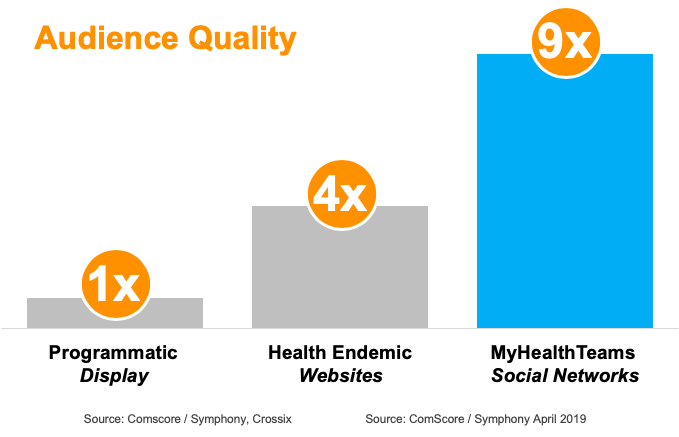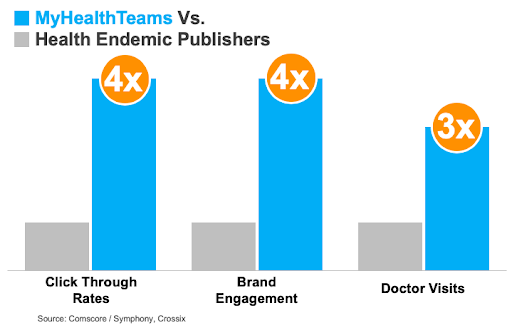 April 19, 2021
April 19, 2021
The Cookie-Free Opportunity for Pharma Marketers in Chronic Condition Care
Pharma marketers trying to reach patients with chronic diseases are scrambling to prepare strategies for the “cookie-less” world awaiting them at the end of this year. In a January 2020 announcement , Google shared it will phase out third-party cookies by 2022, and followed that with another announcement stating it will not replace cookies with an alternative user-level identifier. In this new world, high-quality first-party relationships are vital, and agencies and their clients must think critically about quality through three lenses:
1. Where can I find people diagnosed with the disease my drug addresses?
2. What are they doing while there?
3. How can I effectively engage them in that context?
The first question is about audience quality (how many of the people seeing your ad are diagnosed).
The second is about context quality (are they in a place where they are engaging with people or content regarding their condition).
The third question is about ROI quality (what kind of return you get for your ad spend).
In many ways, the exercise is a re-set to marketing basics – a recommitment to the importance of relationships. In this sector, where we’re focused on individuals’ personal health and wellbeing, this is especially refreshing.
So how can pharma marketers and their agencies best approach engaging chronic condition patients in this evolving landscape?
1) Prioritize Audience Quality
The initial benefit of utilizing third-party cookies was to retarget consumers online so that your message would be seen multiple times by the same user, thereby “breaking through” the clutter. For example, a person visits a website article about multiple sclerosis and your ad for a disease modifying therapy (DMT) then follows her to other sites across the web over the following days and weeks. The problem, of course, is that the person’s behavior often does not accurately reflect their profile. Perhaps she visited the site when signing up to support a friend doing a fundraising walk. Or maybe she visited it because a favorite celebrity was recently diagnosed and she’s now curious about the disease. The other problem is that many patients feel violated seeing a drug ad following them around to other sites that have nothing to do with MS.
Going forward, audience quality has to be top priority when making media buying decisions and first-party relationships are king. For pharma marketers, this means finding diagnosed patients – people living with the chronic disease your therapy addresses. What we see from our data with pharma marketing partners across MyHealthTeams’ 40 condition-specific social networks, is that the audience quality in patient social networks is among the highest in the industry. Independent studies validate this – consistently showing, for example, that someone on MyMSTeam (or any of our other social networks) is typically about 900% more likely to be diagnosed with the disease than someone on the vast majority of health endemic websites (let alone programmatic ad networks). 85% of the people joining one of our social networks are patients diagnosed with the condition, and the other 15% are typically a spouse or parent of a diagnosed patient.

2) Prioritize Context Quality
This goes back to that core question of what is a person doing on the websites where your ad runs? Does it have anything to do with their condition? How long do they stay? How often do they come back? Many third-party cookie-based targeting campaigns benefited from drive-by audience activity. But activity does not equal engagement, let alone impact. Click-bait has lost its luster, and third-party cookies are going away.
The content we find to be most popular among people facing a chronic health condition are the articles and videos that provide disease-specific information – often from a medical expert who brings a specialized perspective – and address the questions weighing on people’s minds. Over the past year, much of this has been tied to Covid, of course.
For example, should someone on MS treatment continue immunosuppressive therapy during the pandemic ?
Or what can someone with COPD do to promote respiratory health while sheltering in place?
Or what does someone with RA need to know about the Covid vaccine?

The pandemic has elevated the patient social network to an entirely new level. We’ve seen a sustained six-fold increase in engagement with MyHealthTeams’ content over the past year – with no sign of slowdown. This is also a reflection of our commitment to community. From day one, our social networks have centered on making it easy for people diagnosed with the same condition to connect with each other – to share firsthand experiences, offer each other practical advice for navigating their “new normal,” and to provide one another emotional support without judgment. Again, the demand for this kind of authentic connection has only grown and deepened over the past year – with every indication that patient social networks are a long-lasting habit.
For a pharma marketer, this context quality packs a powerful punch. You’re not only associating your brand with relevant content – trusted information; you’re also aligning your message with the conversations real people – actual diagnosed patients – are having with each other about that information. As more marketers redouble their focus on first-party relationships, now is the time to be purposeful in defining what context quality means for your brand.
3) Team with Trusted Partners to ROI Quality
Ad effectiveness requires understanding the audience, tuning solutions to suit their behavior, and creating content and experiences that keep them engaged and bring them back. This is a complex equation that requires a mutual commitment to shared success – between the brand, the agency, and the publisher or platform. That starts with listening to consumers. And it must be grounded in trust and two-way accountability.
At MyHealthTeams, we’ve always adhered to a simple litmus test when evaluating the opportunity to work with a pharma marketing partner: 1) Will this benefit our members? and 2) Can we be transparent with them about what we’re doing? Ensuring the answers are “yes and yes” immediately puts us a step ahead on delivering impact – for our members and our partners alike.
We work with pharma partners who share our commitment to improving health outcomes, and collaborate closely to figure out patient-driven ways to achieve them. That starts in the planning phases of an advertising campaign or patient education initiative with us sharing research on the unmet needs of our members, and it carries through every step of the way – implementation, optimization, reporting, etc. When you start out with the intention of delivering something the patient needs, your ads perform better. The best proof of this comes from third-party studies that quantify impact. Consistently, campaigns on MyHealthTeams’ social networks out-perform health endemic publishers by 300-400% on key measures including clickthrough rates, brand engagement, and doctor visits.

Pharma marketing requires tight targeting and a healthy concern for personally identifiable information (PII). Looking ahead, pharma marketers have a remarkable opportunity to lead the advertising industry into its next phase. Collectively, we can spend the next few months really digging in to understand where we’re seeing the highest quality today – across the vectors of audience, context, and ROI. This will put our industry in a strong position to then focus on maximizing impact in a cookie-free future. In the short term, it may require extra effort and tough decisions. But it will ultimately deliver a better result – for brands, for publishers and platforms, and – most importantly – for patients.

